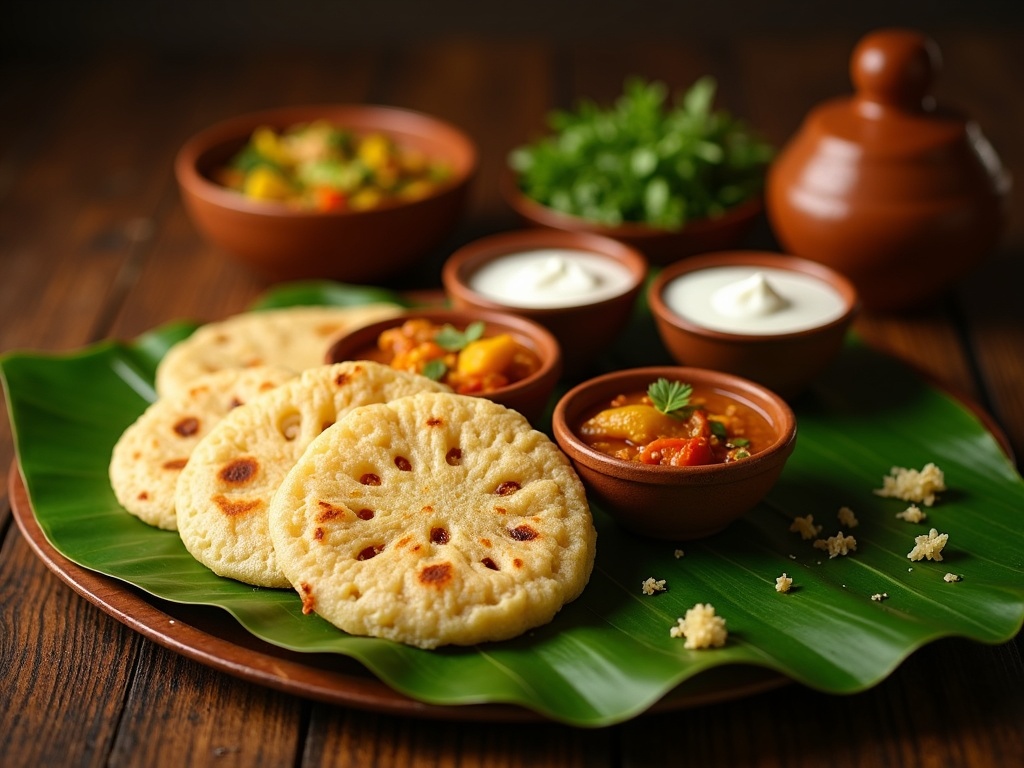Appam, a traditional South Indian pancake from Kerala and Tamil Nadu, features lacy, crispy edges with a soft, pillowy center made from fermented rice batter and coconut milk. This delicacy balances textures and flavors while delivering nutritional benefits through its natural fermentation process, creating a versatile base for both savory and sweet accompaniments.
Find In This Article
Key Takeaways
- The 6-8 hour fermentation process is crucial for appam’s unique honeycomb structure, creating the characteristic crispy edges and soft center.
- Appam is naturally gluten-free with approximately 97 calories per 100g serving, making it accessible for those with dietary restrictions.
- Regional variations include Kerala’s coconut-rich palappam, Tamil Nadu’s thicker version, and sweet varieties made with jaggery and spices.
- Traditional pairings include vegetable stew (ishtu), sweetened coconut milk, and various curries that complement appam’s subtle flavor.
- Beyond being a breakfast staple, appam holds cultural significance in Kerala’s festivals and family celebrations, often prepared as part of elaborate feasts.
What Makes Appam a Beloved South Indian Delicacy
Appam has captured my heart as one of South India’s most treasured culinary creations. This traditional pancake hails from the lush regions of Kerala and Tamil Nadu, crafted from a simple yet magical combination of fermented rice batter and coconut milk. The result is a dish that perfectly balances textures—featuring lacy, crispy edges that give way to a wonderfully soft center.
The Art of Fermentation
The secret to appam’s unique texture lies in its 6-8 hour fermentation process. This crucial step transforms ordinary rice batter into something extraordinary. As the batter ferments, natural yeasts develop, creating tiny air pockets that give appam its characteristic honeycomb structure. I’ve found that proper fermentation is key to achieving those delicate, lacy edges that contrast beautifully with the pillowy center—much like how lemon rice uses acid to transform simple rice into something special.
The careful balance of ingredients also contributes to appam’s distinctive qualities. While the rice provides structure, coconut milk adds richness and a subtle sweetness that complements savory accompaniments. This makes it versatile enough to pair with everything from spicy curries to sweet coconut milk—similar to how jeera rice acts as the perfect canvas for flavorful dishes.
Nutritional Benefits and Accessibility
One of appam’s greatest strengths is its naturally gluten-free composition, making it an excellent option for those with gluten sensitivities or celiac disease. In a world where dietary restrictions can limit culinary exploration, appam offers an inclusive alternative that doesn’t compromise on taste or texture.
The nutritional profile of appam is equally impressive:
- 97 calories per 100g serving
- 2g of protein
- 18g of carbohydrates
- 2g of fat
This balanced nutritional makeup makes appam a satisfying yet light meal option. Its fermentation process also increases bioavailability of nutrients and improves digestibility—something I appreciate when enjoying these delicate pancakes for breakfast or dinner.
Appam pairs beautifully with both vegetarian and non-vegetarian accompaniments. From the rich flavors of chicken korma to the aromatic complexity of vegetable biryani, these pancakes act as the perfect vehicle for soaking up flavorful sauces and curries.
The Art of Making Perfect Appam
Creating the perfect appam is a delightful culinary adventure that brings a taste of South Indian cuisine right to your kitchen. This beloved dish features a soft, spongy center with crispy, lace-like edges that make it uniquely satisfying. I’ve spent years perfecting my appam technique, and I’m excited to share the key elements that will help you master this traditional dish.
The Science of Fermentation
The magic of appam lies in its fermentation process. This critical step creates the signature airy texture and subtle tangy flavor that makes appam so special. To start the fermentation, I combine rice flour with coconut milk, a small amount of sugar, and yeast. The sugar feeds the yeast, which then produces carbon dioxide bubbles that get trapped in the batter, creating that distinctive honeycomb structure.
For successful fermentation, you need to:
- Use room temperature ingredients to encourage yeast activity
- Cover the batter with a cloth rather than an airtight lid
- Place in a warm spot (75-85°F is ideal) away from drafts
- Allow 6-8 hours for complete fermentation
- Look for a batter that has doubled in volume with a slightly sour aroma
The fermentation time varies based on climate conditions. In warmer regions, 6 hours might be sufficient, while cooler areas may require the full 8 hours or even longer. Patience pays off here—rushing this step will result in flat, dense appams that lack the characteristic flavor profile.
Getting the consistency right is crucial too. The batter should be pourable but not runny—similar to pancake batter. If it’s too thick, your appams will be dense; too thin, and they’ll spread too much and lose their defined center and lacy edges. I often check by lifting a ladle of batter and watching how it falls back into the bowl. It should flow smoothly in a ribbon-like stream.
The traditional cooking vessel, called an appachatti, is a curved pan that gives appam its unique shape with a thick center that gradually thins toward the edges. If you don’t have an appachatti, a small, well-seasoned wok or a non-stick pan with curved sides can work as a substitute, though the authentic curved shape will be harder to achieve.
Temperature control is another vital factor. The pan needs to be hot enough to create those crispy edges but not so hot that the appam browns too quickly before cooking through. I typically heat my pan on medium heat, then reduce to medium-low when cooking. A small test appam can help you gauge if the temperature is right.
The addition of fresh coconut milk enriches the appam, giving it a subtle sweetness and contributing to its tender texture. Using fresh coconut milk makes a noticeable difference, though canned versions can work in a pinch. For the best results, I extract my own coconut milk by blending grated coconut with warm water and straining it through a fine mesh.
The cooking technique itself requires a bit of practice. Pour a ladle of batter into the center of your hot pan, then quickly pick up the pan and swirl it so the batter coats the sides thinly while leaving a thicker portion in the center. Cover and cook for about 2 minutes until the edges turn golden brown and crispy while the center remains soft and pillowy.
With these techniques mastered, you’ll be creating restaurant-quality appams that will impress family and friends alike. Remember that practice makes perfect, and each batch will bring you closer to appam perfection.
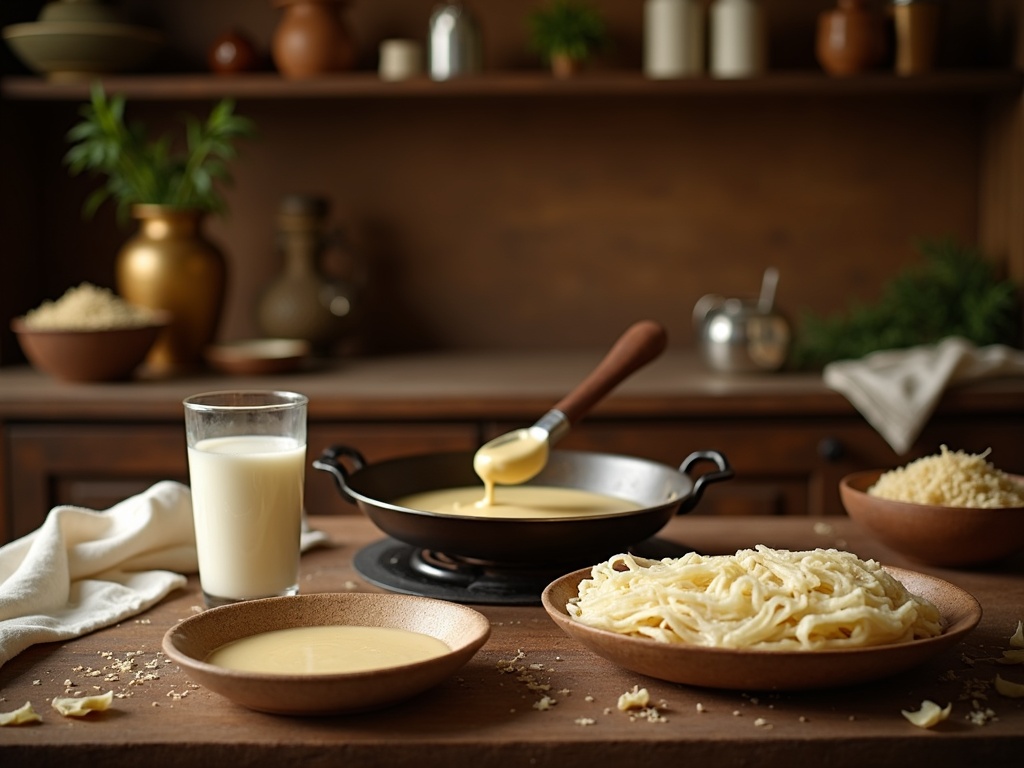
Popular Appam Varieties Across South India
The world of South Indian cuisine offers a diverse range of appam varieties, each with unique characteristics that reflect local traditions and preferences. I’ve discovered that understanding these regional differences can enhance your appreciation for this beloved dish.
Traditional Varieties
Plain appam stands as the foundation of all variations. Made primarily with rice and coconut milk, this lacy pancake features a soft, spongy center and crispy edges. The fermentation process gives plain appam its signature tangy flavor that pairs perfectly with spicy chicken korma or vegetable stew. The batter consistency is crucial – not too thick or thin – creating that characteristic bowl shape when cooked in the appachatti (traditional pan).
Kallappam offers a more robust texture and enhanced flavor profile compared to its plain counterpart. This variety uses fermented toddy (palm wine) as a natural leavening agent, resulting in a thicker pancake with extra tanginess. The fermentation happens faster with toddy, giving kallappam a distinct aroma that many South Indians find irresistible. It’s commonly served with fish curry or rich butter chicken for a satisfying meal.
Egg appam transforms the basic recipe with the addition of an egg cracked into the center while cooking. As the appam cooks, the egg sets directly in the middle, creating a protein-rich focal point surrounded by the familiar soft, lacy edges. This variety offers a complete one-dish meal when paired with tangy lemon rice or simple coconut chutney.
Sweet appam represents the dessert version of this versatile dish. By incorporating jaggery and grated coconut into the batter, this variation delivers a naturally sweetened treat often served during festivals or special occasions. Some versions include cardamom, banana, or even a touch of ghee for added richness. Sweet appam pairs beautifully with morning coffee or as a light dessert following a spicy vegetable biryani.
Regional Specialties
Each South Indian state has put its unique stamp on appam preparation:
- Kerala‘s palappam emphasizes coconut milk, creating an incredibly soft center with lacy, crisp edges. The distinctive bowl shape allows it to hold curry perfectly. Often served with stew (ishtu) for breakfast, this version embodies the coastal influence on Kerala cuisine.
- Tamil Nadu offers a slightly thicker variation with more defined edges. Their appams typically contain a bit more rice flour for structure and are commonly served with coconut milk sweetened with jaggery or a savory vegetable korma.
- Karnataka‘s version, sometimes called akki appam, often incorporates rice flour rather than fermented rice batter. This creates a denser texture that stands up well to hearty accompaniments like aromatic pulao or sambar.
- Coastal Andhra Pradesh features appams with a higher proportion of coconut, reflecting the region’s abundant coconut groves. Their appams are slightly sweeter naturally and pair wonderfully with spicy seafood curries or fragrant jeera rice.
The beauty of appam lies in its adaptability. While preserving the essential characteristics that make it beloved throughout South India, each region has tailored this dish to complement local ingredients and tastes. Whether you prefer the traditional plain version or want to explore regional specialties, appam offers a delicious window into South Indian culinary traditions.
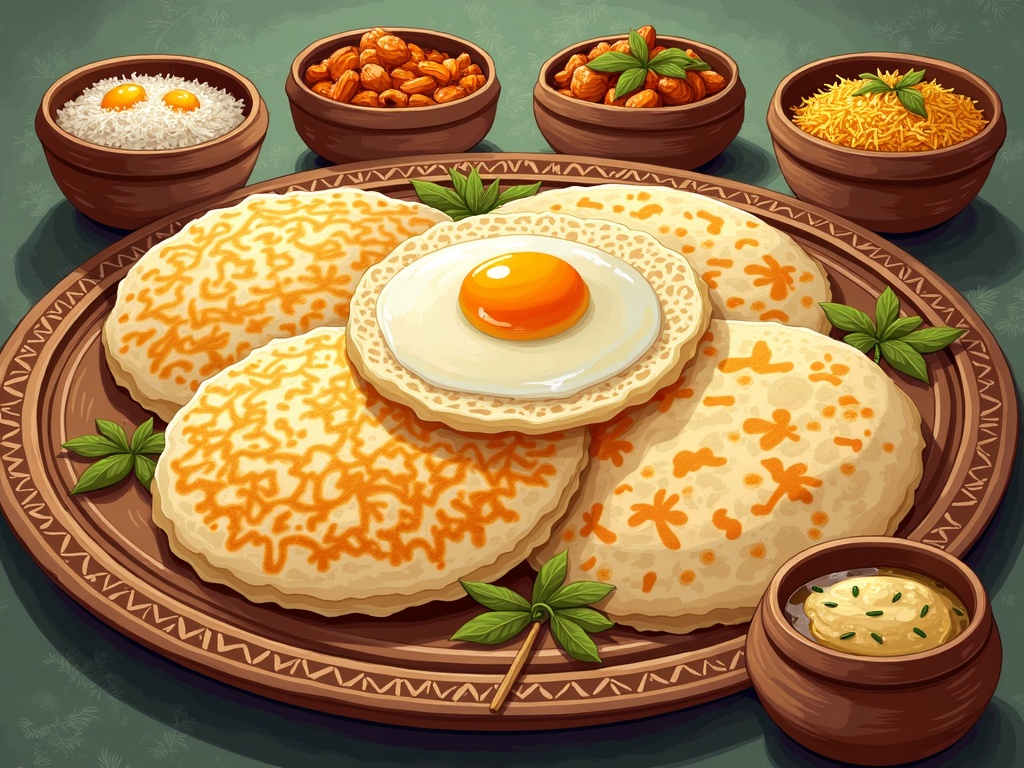
Traditional Pairings and Serving Suggestions
Appam’s fluffy center and crispy edges make it an incredibly versatile dish that pairs beautifully with numerous accompaniments. I’ve found that the right pairing can transform this humble pancake into a memorable meal, whether served for breakfast, lunch, or dinner.
Classic Accompaniments
The most traditional way to enjoy appam is with vegetable stew (ishtu), a mild, coconut milk-based curry that perfectly complements appam’s subtle flavor. The creamy, aromatic stew seeps into the spongy center of the appam, creating a delightful texture contrast. For protein lovers, chicken curry dishes offer a robust pairing that adds depth to the meal. The spicy notes of the curry blend harmoniously with appam’s mild taste.
Plain coconut milk sweetened with a touch of jaggery is another simple yet satisfying accompaniment, especially for breakfast. Some families serve appam with a side of tangy lemon rice for a unique flavor combination that showcases South Indian cuisine’s diversity.
Sweet and Savory Variations
Appam’s neutral flavor profile makes it perfect for both sweet and savory interpretations:
- Sweet pairings include honey, banana slices, or cardamom-infused coconut milk
- Egg appam features an egg cracked directly onto the cooking batter
- Neyyappam is a sweeter, deeper-fried variation with jaggery and ghee
- Palappam incorporates more coconut milk for extra richness
For a quick meal, I sometimes pair appam with creamy butter chicken, though this is a modern fusion approach rather than traditional. The mild, slightly fermented flavor of appam balances beautifully with rich, spicy gravies like those found in vegetable biryani dishes.
Street food vendors have created innovative adaptations like appam pockets stuffed with spicy potato fillings or vegetable mixtures. These portable versions maintain the essence of appam while making it suitable for on-the-go eating.
When hosting guests, I create an appam spread with multiple sides including aromatic pulao and fragrant jeera rice, allowing everyone to customize their plates according to preference. This approach showcases appam’s remarkable adaptability while honoring its traditional roots in South Indian cuisine.
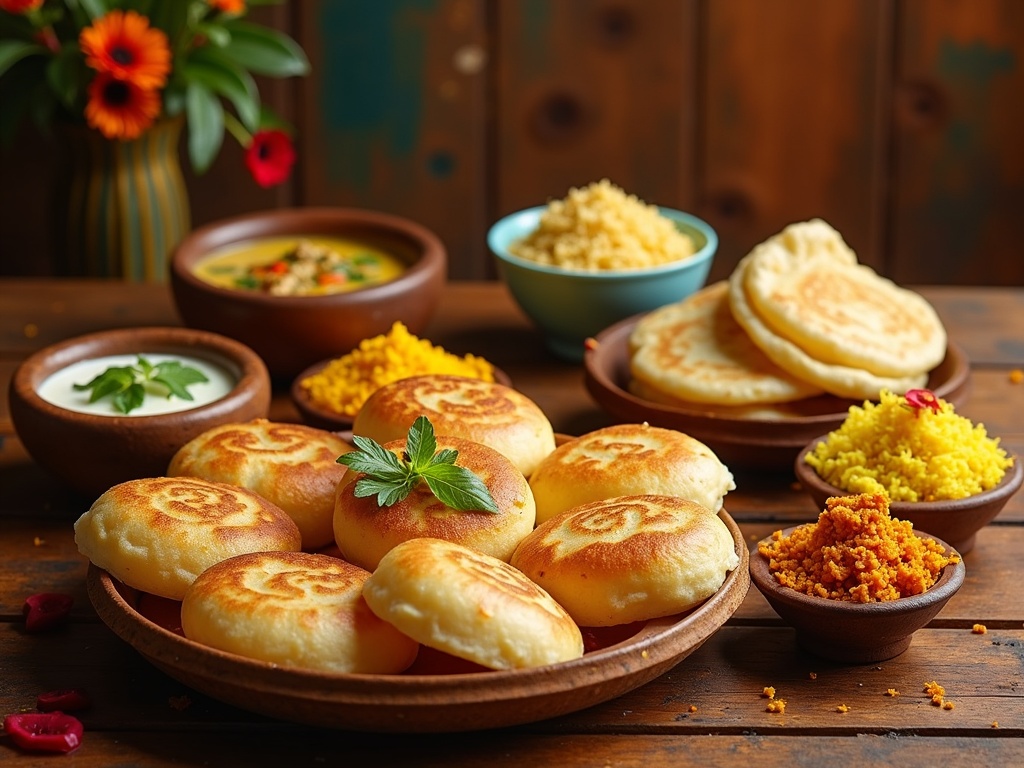
Cultural Heritage and Festival Significance
Appam holds a central place in Kerala’s Christian community cuisine, carrying deep cultural roots that span generations. I’ve observed how this delicate, bowl-shaped pancake transcends being merely a breakfast item to become a symbol of heritage and celebration across South India.
Festival Connections and Traditions
During Kerala’s major festivals, appam emerges as a star on traditional banana leaf spreads. For Onam, the harvest festival celebrating King Mahabali’s annual return, families prepare appam as part of the elaborate Onasadya (feast). The soft, lacy edges and spongy center create the perfect companion for flavorful korma dishes served during these celebrations.
Similarly, Vishu festivities showcase appam alongside other traditional delicacies. The neutral taste profile makes it an ideal base for both sweet and savory accompaniments. Many households serve it with:
- Sweet coconut milk infused with cardamom
- Spicy vegetable stew with fresh coconut milk
- Kadala curry (black chickpea curry)
- Egg roast or mappas (meat in coconut gravy)
The communal preparation of appam represents hospitality in South Indian culture. I’ve witnessed how the process of fermenting the batter overnight and cooking each appam individually in the morning becomes a labor of love, especially when preparing for large gatherings. This dedication mirrors the importance of aromatic rice dishes in Indian hospitality traditions.
Historically, appam evolved from ancient trade connections with Middle Eastern cultures, adopting local ingredients and techniques. The traditional appachatti (curved pan) remains essentially unchanged for generations, preserving authentic cooking methods despite modern kitchen innovations.
What fascinates me most is how appam creates connections during special occasions. Family gatherings for Easter, Christmas, and weddings always feature appam prominently. The preparation process often becomes multi-generational, with elders teaching younger family members the precise techniques for achieving the perfect texture and balancing flavors in the accompanying dishes.
Beyond religious celebrations, appam appears at house-warming ceremonies and milestone birthdays, reinforcing its status as both everyday sustenance and celebratory food. This versatility has helped maintain its cultural significance even as dining habits evolve in contemporary Kerala society.
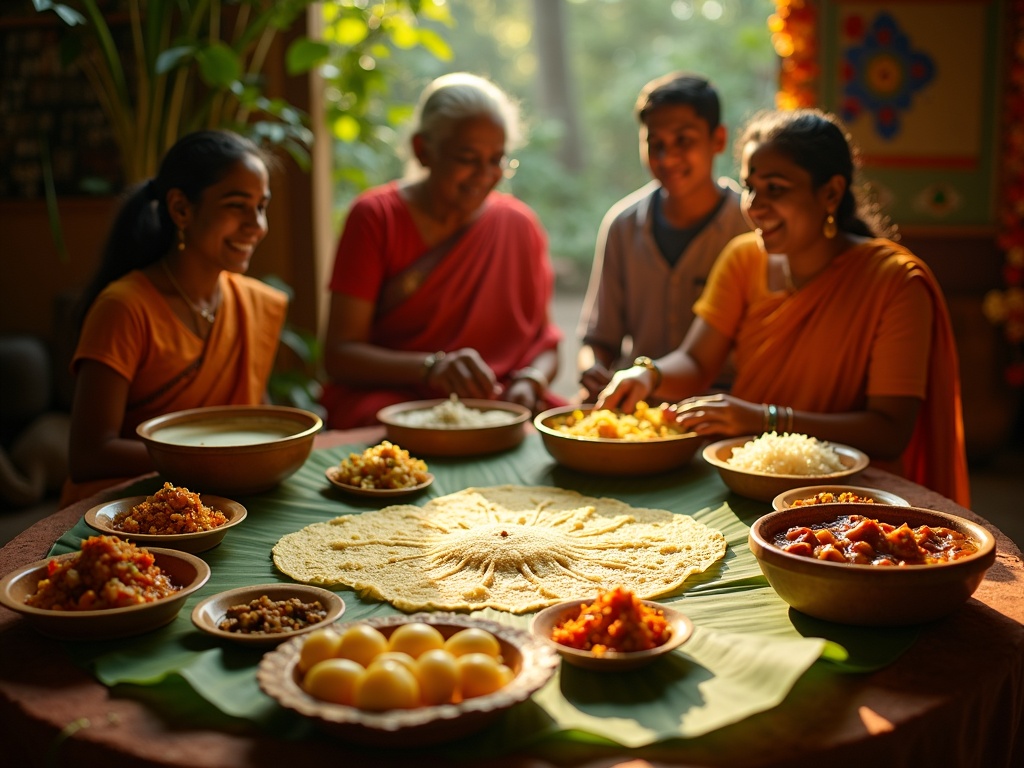
Health Benefits and Modern Adaptations
Appam has gained popularity beyond its traditional South Indian roots, largely due to its nutritional profile and adaptability. I’ve found that compared to traditional American pancakes which contain approximately 250-300 calories per serving, appams typically have just 120-150 calories, making them a lighter breakfast option.
Nutritional Advantages
As a gluten-free alternative, appam offers an excellent option for those with celiac disease or gluten sensitivities. The fermentation process involved in preparing appam batter enhances its digestibility and creates beneficial probiotics. This fermentation also increases the bioavailability of nutrients, particularly B vitamins.
The rice-coconut combination in appams provides a balanced nutrient profile:
- Complex carbohydrates from rice offer sustained energy release
- Coconut components deliver healthy fats and medium-chain triglycerides
- The fermentation process introduces beneficial probiotics
- Natural ingredients provide essential minerals like iron and calcium
When compared to wheat-based breakfast options like toast or cereal, appams deliver more diverse nutrients while avoiding common allergens. I often recommend rice-based dishes like appam to clients looking for gentler breakfast alternatives.
Modern Adaptations
Traditional appam recipes have evolved to accommodate contemporary dietary preferences. Health-conscious consumers now enjoy variations that align with specialized diets:
Millet appams substitute traditional rice with nutrient-dense millets like foxtail, barnyard, or finger millet. These alternatives boost the fiber content and provide additional micronutrients while maintaining the classic texture. For those seeking higher protein content, adding cumin-flavored rice flour or incorporating lentil flour creates a more filling breakfast option.
I’ve noticed how chefs are incorporating unexpected ingredients into appam batters. Vegetable-infused variations incorporate pureed spinach, beetroot, or carrot, boosting the nutritional value while creating visually appealing dishes. For those following keto or low-carb diets, cauliflower and coconut flour appams provide the beloved texture and taste without the high carbohydrate content.
The versatility of appams extends to vegetarian cuisine, where they pair beautifully with plant-based curries and chutneys. Savory versions often include herbs and spices that carry additional health benefits, such as turmeric, fenugreek, or curry leaves.
Sources:
The Complete Indian Cookbook by Charmaine Solomon
India: The Cookbook by Pushpesh Pant
Kerala Cuisine: A Spice Odyssey by Shalini Rajendran

